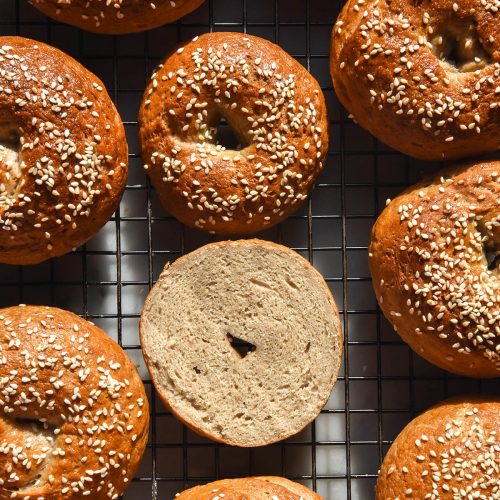
Gluten free high protein bagels
*Cups and measures are in Australian cups and measures. Use gram and ml for international accuracy.
Ingredients
For the dough:
- 500 g light buckwheat flour
- 25 g psyllium husk powder
- 7.5 g (1 sachet)* yeast
- 5 g fine salt (see notes)
For the blended mixture:
- 500 g cottage cheese (see notes)
- 200 g water
- 60 ml (3 tablespoons)* neutral oil (I used vegetable)
- 40 ml (2 tablespoons)* maple syrup or honey
To finish:
- 1 teaspoon baking soda this helps create the shiny, brown bagel crust
- 1 egg whisked for egg wash or egg wash alternative
- Sesame seeds poppy seeds or bagel topping of choice
Instructions
- Whisk the dry ingredients for the dough in a large non-reactive (plastic or glass) mixing bowl.
- Combine the ingredients for the blended mixture in your blender and process until combined.
- Pour the blended mixture into the dry ingredients. Use a spoon and then your hands to mix until all the dry flour is picked up off the bowl. The dough should be thick and sticky but there should not be dry flour or crumbly bits of dough. Add 1 tablespoon water at a time if this is the case, and continue to work the dough until it becomes smooth.
- Cover the bowl and leave on the bench to proof for 30 minutes.
- While you wait, thoroughly preheat the oven to 180C/356F.
- Fill a medium pot 3/4 of the way with water. Set it over a medium heat and bring to a boil.
- Once the dough has proofed for 30 minutes, divide it into 9 or 10 balls. Depending on how sticky the dough is, you may need to lightly flour the bench (I use tapioca flour) or you may not.
- To form bagels, you can either roll out each piece of dough into a log and then brings the ends firmly together (use water on the ends to ensure they seal together) or you can form bagel sized disks of dough and use an oiled finger to create the bagel hole. Visually, I prefer the first option, but the second option is a bit easier and more foolproof.
- When the water has boiled, add the teaspoon of baking soda. It will bubble very briefly. Place each bagel into the water for 30-45 seconds, flipping halfway through. Place each boiled bagel on a lightly oiled cooling rack to drain the excess water while you boil the next one. Note that they will take on the indents of the rack, so place them with the prettiest side upwards.
- Once you have boiled all the bagels, place them on a lined baking tray.
- Brush each bagel with egg wash or an alternative, and then sprinkle with your chosen topping.
- Bake for 25-30 minutes or until golden, puffy and firm.
- If you are using a high hydration, wait until the crumb sets to eat one or else your bagel will be gummy. Leftovers keep really well for a number of days and can be frozen (I like to slice them prior to freezing).
Notes
- This recipe does not bloom the yeast, so make sure your yeast is well in date. If you are worried, bloom with 1/4 cup water and 1 teaspoon sugar. Subtract the water from the 200g for the dough.
- Cottage cheese already contains a decent amount of salt. Although the bagels (to me) don't taste sufficiently salty without added salt, you can omit it for a low sodium diet. You can also make your own cottage cheese, then add salt to suit.
- My recipe for lactose free cottage cheese is here.
- Read the body of the post for notes and substitution options (or lack thereof). I have also linked other recipes that are suitable to vegan/dairy free diets.
Tried this recipe?Let us know how it was!